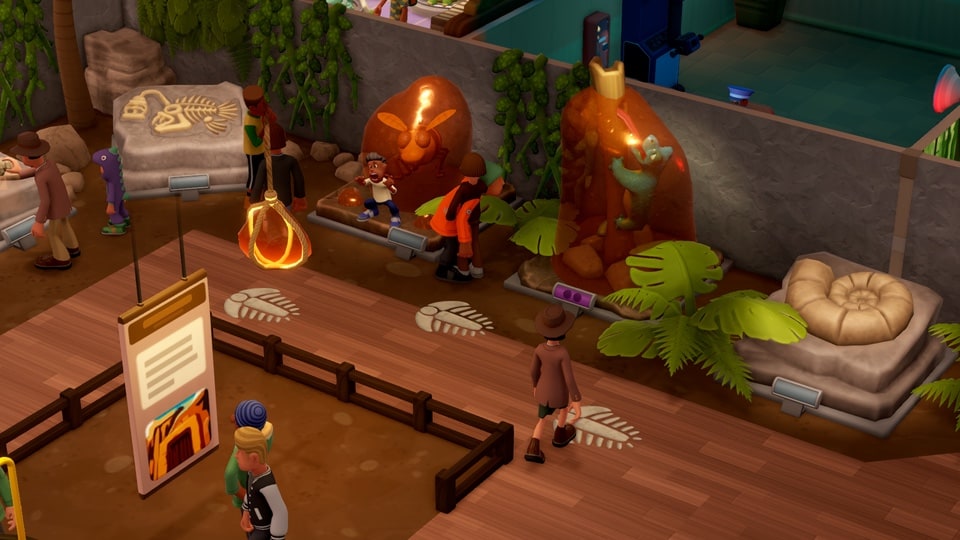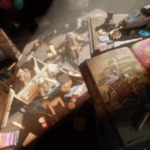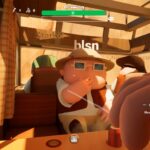It used to be something of a marvel to see fully fledged PC and console games being ported across to Nintendo’s consoles, whether we look as far back as the Wii, or consider the number of “impossible” ports to the original Nintendo Switch. With the dawn of the Nintendo Switch 2, though, these kinds of ports are almost expected. Given that the earlier Two Point titles made the jump to the original Switch, how does Two Point Museum fare on the newer console?
Two Point Museum is another charming take on the management sim, filled with irreverent humour and bucket loads of puns to bring a wry smile to your face. At its core you’re still doing similar tasks to Two Point Hospital, creating rooms and a flow for patrons to follow, managing your staff, and just trying to make as much money as possible, but there’s a very different theme to Two Point Museum and a much more obviously creative endeavour behind constructing your museum.
But before you can place attractions in your museum and build and theme exhibits around them, you first need to acquire them, sending your experts out to various locations to dig up new and unusual fossils, to catch different rare fish, to… hunt ghosts and haunted mannequins? These aren’t your standard history museums, that’s for sure!
With this Switch 2 version arriving almost eight months after the original release, there’s already been a bunch of updates and DLC that are thankfully represented in this port. The Fantasy Finds DLC is available separately, but there’s also the Digiverse collaborations with smaller and indie games like Dredge and Vampire Survivors which are already in this game. We still want to see DLC that adds more levels and locations to build in, and we’ll always dream about added features like multiple floors, but this is in lockstep with the game on other platforms.
But the most important factor is how the game plays, and for me, this Switch 2 release is a very enjoyable rendition of this game… with some caveats. The game fundamentally looks great, the chunky art style helping to minimise the impact of lower texture detail and reduced floor reflections and other effects, and it’s being rendered at a high enough resolution that it looks nice and smooth on the Switch 2’s screen when playing handheld, and even on larger screens. That’s pretty great, but the caveat is that the frame rate can and does suffer as your museum grows.
Even by the time you’ve reached the end of the first museum’s first mission, you start to feel the CPU limitations of the Switch 2. There’s some noticeable little stutters and hitches as you load into object picking menus and snap to a room to modify, but more fundamentally, it’s just the game needing to simulate a couple hundred guests and staff as they amble around your museums, and while viewing from a stationary camera is fine, you start to feel the stutter when panning around. It’s dependent on the simulation speed, so pausing the action makes camera movement nice and smooth again, with frame rate struggles getting a little worse as you speed things up.
It’s worth noting here that the Switch 2 version deliberately keeps the guest count in check. It defaults to a 200 guest limit (which can easily be stuffed into a basic museum space) with an option to bump that up to 300, but the PC game defaults to 400 guests with a range from 200 to having no limit at all.
And to me, I think that’s totally fine. This isn’t a genre where you need twitch reactions, and regardless of the frame rate, I’m someone that makes many building and room modifications while the simulation is paused. Maybe at the start as I’m slapping down a quick room blueprint in a basically empty space, but as soon as I’m having to overhaul an active area, and when guest satisfaction is an evolving metric, it’s best to do this when paused.
Unfortunately, the game does feel a little bit glitchier on Switch 2 than I remember from playing on PC. We’ve had a couple of game crashes on this console and a soft lock that needed us to restart, and that can be a tad inconvenient depending on when the last autosave was. There were also some weird problems, like one of the Bandage Box healing chairs just repeatedly catching fire five or six times in just a matter of minutes, we’ve got a ghost stuck outside of their room that nobody cares about, some visual effects like fire and smoke are just rendering as grey squares, and there’s some missing tooltips that make getting around the menus a bit confusing at times. Most of the issues we found are highlighted for a post release patch, but it’s a shame they’re here on day one.
I do also think that playing with a gamepad feels a bit clunky at times. They’re generally OK to understand and there’s plenty of tooltips, but the way that buttons are context sensitive as you get into a room’s menu always has me pausing to think about what button I need to press.
That’s not a problem on PC, of course, when you’re clicking around the UI with a mouse. Hey, wait a minute, the Switch 2 has that mouse mode, doesn’t it? Sadly, Two Point Museum doesn’t have Joy-Con mouse mode support at launch, and while the team have said they’re looking into it, they’re rather non-committal about the possibility.








